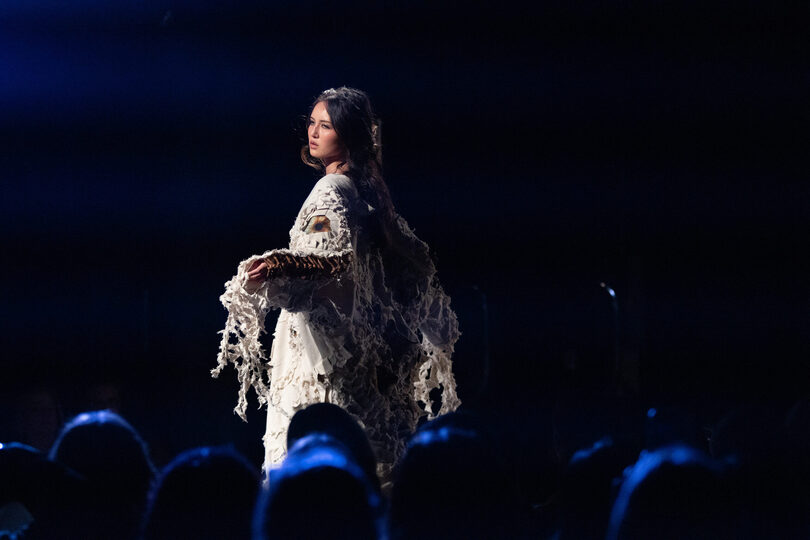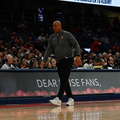FADS, Phi Delta Epsilon partnership brings anatomy to life in spirited fashion show

Outfits from student designers represented parts of the body like the digestive and endocrine systems. A one-piece suit depicting the part of the body came down the runway first, followed by student designs inspired by that part. Zabdyl Koffa | Staff Photographer
Get the latest Syracuse news delivered right to your inbox.
Subscribe to our newsletter here.
Under the bright lights of Schine Underground, models moved with quiet confidence as they showed off the latest student designs — based on body systems. For many designers, like Anya von Wolff, the show marked the moment their hard work turned from sketches and fabric into something real.
“Being able to witness people enjoying what you’ve worked hours and hours on is the most rewarding thing in the world,” von Wolff said.
Syracuse University’s Fashion and Design Society partnered with Phi Delta Epsilon, SU’s pre-medical professional fraternity, to host SU’s first Anatomy Fashion Show on Saturday. The event was a benefit for Children’s Miracle Network Hospitals. PhiDE raised a little over $2,600 as of Saturday, Vice President of Finance Lydia Van Boxtel said.
Senior fashion design major Jada Williams, the FADS president, said the idea came straight from PhiDE.
“They kind of came to us with the idea to do an anatomy fashion show,” Williams said. “We were on board for it 100%, especially when they mentioned that this was going to be for the Children’s Miracle Network.”
For Williams, the show represented more than just another runway. It was a chance for FADS to step outside of the box and collaborate with another campus organization for a cause that mattered.
FADS Vice President Grace Kentrotas, a senior studying public relations, said no two days looked the same in the lead up to the show.
“It’s a lot of just kind of filling in gaps,” Kentrotas said. “There’s so many moving parts; we oversee designers, a set team, stylists, hair and makeup, kind of everything you can think of.”
For this show in particular, Kentrotas’ role was liaison between PhiDE and FADS. Kentrotas said having a team that communicates well was a big factor in the show’s success. One of the challenges for FADS was the coordination and logistics. With everyone having full schedules, having time to get together took a lot of time management and organization.

Lydia Van Boxtel, center, is the Vice President of Finance for PhiDE. When she ran for the position, bringing the Anatomy Fashion Show to Syracuse was one of her main goals.Zabdyl Koffa | Staff Photographer
Van Boxtel said this event was months in the making and the planning started in March. Designers spent late nights sewing and sculpting, models practiced choreography and organizers juggled logistics that brought it all together, she said.
Van Boxtel said anatomy fashion shows happen nationally, with almost every PhiDE chapter participating. She wanted to be the one to bring the show to SU, and partnering with FADS added a special twist.
Usually, anatomy fashion shows consist of one-piece suits painted to represent the different body systems. For this show, PhiDE’s anatomically painted suits inspired accompanying looks by FADS designers. Each anatomical system had two to three looks in total. Some of the designers used layers of fabric twisting to create muscle-like designs. They also used metallic accents and detailed stitching.
“Typically it’s just the anatomically painted suits and then someone gives a talk on the different organ systems,” Van Boxtel said. “We reached out to FADS and asked them if they would be interested in collaborating with us and making inspired designs.”
Sophomore Vitor Kobbaz joined the show as a first-time model. He walked for the reproductive system. It was a positive experience with lots of learning, meeting new people and creating new relationships, he said.
Kobbaz was impressed with the outfits and couldn’t believe he got to wear some of them. He said he wanted to be confident and purely himself when walking down the runway.

Designers from the Fashion and Design Society researched different body systems to inform their pieces. Some designers twisted fabric to take the shape of muscles or used metallic accents. Zabdyl Koffa | Staff Photographer
When Van Boxtel applied for the vice president role, bringing the fashion show to SU was her main goal. Because the event takes so long to plan, it was hard for PhiDE to put on the show in previous years, she said.
Despite the extensive planning, Kentrotas’ favorite part about each show is the moment when the chaos stops and watching the show happens. Getting to see what they’ve worked on all semester and seeing everyone’s creative vision is super cool, she said.
Von Wolff’s inspiration came from not only past creative projects, but also researching the different systems to develop them into looks. She created designs for the digestive and endocrine systems.
“To have a mind that is so creative in that sense where I can look at something that isn’t creative at all and picture kind of how I could morph it into something that’s wearable,” von Wolff said. “That’s where I feel the inspiration comes from.”
Both FADS and PhiDE executives agreed that the fundraiser was the most rewarding part of the process.
“I hope people recognize that this is something really important for our local community and directly helping out,” said Van Boxtel.






